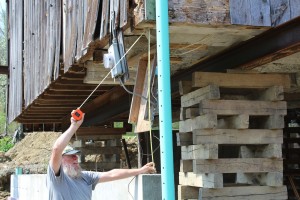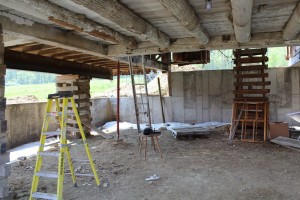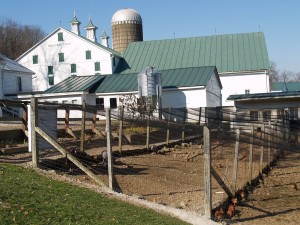(Scroll down for video)
MEADVILLE, Pa. — At the end of an old farm lane in Crawford County, Pennsylvania, sits a worn and weathered bank barn from the mid-1800s.
Like hundreds of other old barns across the country, this one is showing its age. Moisture has caused some of the beams to rot, some have cracked, and the whole barn has shifted and settled over the years.
But unlike many old barns in Pennsylvania, and across the U.S., this one is on a path toward restoration.
The owner, Dan Williams, has hired professional barn restorer Rudy Christian, of Burbank, Ohio, to bring the barn back to life — closely resembling its condition when it was built, around the 1840s.

Williams’ parents bought the 90-acre farm in 1960, and he and his siblings lived there as children, at one point growing Christmas trees, and raising some beef and other livestock under the barn.
Now, Williams, who is 54 and a consultant for a civil engineering firm, wants to see the barn preserved. But he also wants to share it with the public, through local colleges and educational events.
Williams, who also is an artist and painter, hopes to open the barn to educational programs at his alma mater, Allegheny College in nearby Meadville. He also wants to open a studio in the lower level, that could house some of his artwork, or community functions.
Most of the barn, especially the upstairs, is being restored to 1840s conditions — including timbers that will be selected and cut down from the same farm — and some of them will be hand-hewn with an ax.
Modern use
The lower level features many of the same characteristics, but is being modernized a bit, to include a poured concrete foundation, insulation and footer tiles. It’s what builders often call “adaptive-reuse,” which means the barn is still being restored, but in a way that provides new uses for today’s owner.
“My goal is not to preclude its use in the future for animals, but to nevertheless put a foundation under there that will ensure its survival,” Williams said. “I’m interested in it as a way to communicate about farming and these older structures.”

To get there, Williams is relying on Christian — one of the few people who still do this kind of work, the same way it was done more than 150 years ago.
The two met several years ago, when Rudy was helping to rebuild an old timber-frame barn that some vandals had burned. Williams liked the craftsmanship he saw, and kept in touch with Christian.
Connecting to past
According to Christian, who is a founding member of the Timber Framers Guild, people are drawn to adaptive reuse because it gives them a connection to their history, while providing new uses for old buildings.
“Even though you may not be using a barn as a barn when you use it adaptively, it still contains all of those characteristics,” he said. “You don’t lose the knowledge that the barn contains — you just offer that knowledge to a different group of people, in a different environment than it was before.”
And Christian should know.
He and his wife, Laura, live in the timber frame of an 1815 church that they relocated from Oxford, New York, to their property in Burbank, Ohio. They used the original structure to rebuild parts of the church, while adding some braces and interior posts, as well as a wooden-framed second floor, to create their house.
Something righteous
Today, as Christian walks from room to room across the old wooden floors, he thinks of his home as more of a house than a church. But in some ways, it’s still both.
“I do think that it’s very righteous in the fact that every single timber in here was a growing tree in New York State, that was cut down with an ax, by a woodsman, (and) was hand-hewn into squares by a carpenter,” he said.
Even though the couple have lived in the house for about eight years, they still find new treasures. If you look closely, you can even see some of the notes and signatures engraved into the wood by the original builder.
“When you’re in this building, it’s impossible not to relate to the tradespeople who built it,” Rudy said. “The work of the tradesmen is in your face.”
Rudy has been a tradesperson himself for most of his life. Although he didn’t get into timber framing until the early 1980s, he grew up doing small projects with his father, Andrew. One of his first projects was a bridge that he and his father built, over a creek.
Rudy continued his construction career with a factory job that he held in Barberton, Ohio, and through a home renovation company he founded in the 1970s, called Mycroft Homes.
•••
New direction
But it was in 1982 when he discovered his greatest success — timber framing.
Laura had seen a newspaper ad about a timber framing workshop to be held at Kenyon College, in Knox County, Ohio, and they decided they would at least see what it was about.
“We really didn’t know much of anything about it, but we knew that we had old, antique tools that people had collected, that people told us were barn builders’ tools,” he said.
The couple packed up their 1973 Winnebago and headed south to the workshop, where they met tradesmen from around the country.
Rudy said he knew right away that he wanted to do timber framing, not only because of the knowledge of the workshop leaders, but because they were smiling and content as they worked.
“That’s what I want to do,” he said. “I want a job that makes me smile all the time.”
Rudy had jobs lined up as soon as the workshop was over, and about the same time, he launched his own timber framing company, called Christian & Son. In the early years, he worked alongside his dad, and later on, his son, Carson, joined in.
Going national
Rudy also became a founding member of the Timber Framers Guild, an internationally recognized group of about 2,000 members. He was president for seven years, and landed projects like the Hancock Shaker Village in Massachusetts, the Malabar Farm barn raising in 1994, and the Thomas Edison Chemistry Lab, which was relocated from Michigan to New Jersey.
“We were meeting lots of people who obviously loved what they were doing, and it gave us a resource,” he said.
When Rudy started his business, resources were scare. The original barn builders were long deceased, and there were few publications about this type of work. Rudy and other timber framers were often the only resource they had.
Today, he blogs about his work for Traditional Building Magazine, and he holds workshops across the country to teach others about the timber trade. The workshops attract other tradesmen, but also beginners, and even young children.
He recalled meeting a young boy at the Ag Progress Days, in Pennsylvania, who he showed how to drill, and then that’s all the boy wanted to do.
“I can give a 5-year-old kid one of those (hand-crank) drills and he can drill a 2-inch hole, and he’s not going to get hurt,” Rudy said.
As Rudy sees it, learning a trade requires experience. You start by doing an apprenticeship and following someone with more experience, and then you learn to master and share your craft with others.
“It’s experiential,” he said. “You can’t learn a trade by reading a book or taking a test. You can’t even learn a trade by having someone else show you how to do it. Until you screw up yourself, you don’t learn what you did wrong.”
• • •
Something big
Rudy landed his biggest project, and what would become one of his biggest tests, during the 1994 barn raising at Malabar Farm State Park.
Located in Richland County, this iconic farm was the homeplace of Pulitzer Prize-winning author, farmer and conservationist, Louis Bromfield.
Bromfield died in 1956, and in 1993, the historic “Big Barn” was destroyed in a fire. The state of Ohio was obligated to maintain the farm the way that Bromfield had, and that meant the barn would need to be rebuilt.
There was just one problem though — few people at the time, including those bidding on the project, knew how to do historical barn work.
“They (the state) knew they had to replace the barn, but they didn’t have a clue how you could do that, because they didn’t know if there were even people who did that kind of work,” Rudy said.
In fact, he was just getting started with barn building himself. He relied on what he already knew about timber framing, and what he could learn from his own research.
In the end, he was awarded the contract for the timber frame.
Major undertaking
The whole project was a major undertaking. Rudy and his wife hired eight full-time timber framers for three months, renting them living space and providing them with meals.
But the project probably wouldn’t have gotten done if it weren’t for the support of the public, and volunteers. During the Labor Day weekend of Sept. 3-5, 1994, more than 25,000 people attended the raising of the frame, including the general contractor, R G Beer Corp., and about 150 volunteers.

According to Rudy, the Malabar barn raising was believed to have been the largest barn raising of its kind in the 20th century.
It also served as a starting point for Ohioans who would later form the Friends of Ohio Barns group, a statewide organization of barn enthusiasts.
Rudy was surprised at the large crowd that came to watch him and others work — and it empowered him to keep building.
And more than anything, it empowered him to keep sharing.
Sharing the trade
Over the years, Rudy and his wife have continued to offer workshops on timber trades, from New York to California, and from adults, to small children.
Laura recalled a time when they were leading a workshop in New York City, for school-age children, and having a hard time keeping the children’s attention. Then, a brave young girl in the crowd, who was actually a ballerina, gave the two-man saw a try, and then some chisels.
Pretty soon, the ballerina had the boys and everyone else involved, “because she showed them all up,” Laura said.
As Rudy puts it, tradespeople have a responsibility to pass on the trades, and teaching others “makes me feel like we’ve completed the things that we’re supposed to.”
The barn he is restoring in Meadville is his latest example — of not only saving an old barn, but the trades themselves.
 Williams (the barn owner), said he wants the barn to be a place to communicate to others about farming, and about old structures — during the restoration and long after.
Williams (the barn owner), said he wants the barn to be a place to communicate to others about farming, and about old structures — during the restoration and long after.
He considers himself an “average” man with an “average” piece of land, but also something that holds value to him and others, and to those who came before him.
By restoring it, he’s preserving that value and the same work ethic that first built it.
“Land that’s cared for will take care of you,” Williams said. “And that’s what happened in my (family).”
He added, “I like to think, hopefully, they approve of what we’re doing.”
Learn more:
• To learn more about Christian & Son, of Burbank, Ohio, visit www.christianandson.com, or call 330-624-7282.
• You can learn more about the Timber Framers Guild at www.tfguild.org; and you can learn about Friends of Ohio Barns at www.friendsofohiobarns.org.
• If you’d like to follow Rudy’s blog, and see other blogs and articles by timber framers, visit Traditional Building magazine online at www.traditional-building.com.
• To learn more about Dan Williams, the barn owner mentioned in this article, visit www.dhwilliamsart.com.
STAY INFORMED. SIGN UP!
Up-to-date agriculture news in your inbox!











Thanx Chris. Very nice article. You have a gift for listening I wish more reporters had.
Nice write up.
Great writing. Thank you for this.